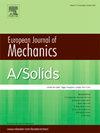Random phase field method for quasi-static and dynamic fracture propagation: Strict phase field equations based on variational principle
IF 4.2
2区 工程技术
Q1 MECHANICS
引用次数: 0
Abstract
Spatial variability in mechanical properties significantly affects fracture evolution in materials. A strict random phase field model suitable for spatially heterogeneous materials is developed, in which a gradient term of the critical energy release rate is introduced. Compared with the simple integration of traditional finite element models with random fields, which involves merely replacing deterministic mechanical properties in the governing equations, a more accurate coupling approach is adopted by incorporating a coordinate-dependent critical energy release rate into the energy functional, which is reformulated from existing models. The governing equation of the phase field is derived through variational principles. Unlike traditional random phase field models, the proposed model captures the spatial variation in the gradient of the critical energy release rate and effectively characterizes the directional rate of change in fracture toughness. The proposed model is implemented by using COMSOL Multiphysics and MATLAB, and validated through the rock fracture experiment. Quasi-static and dynamic fracture simulations reveal that in the presence of pronounced spatial heterogeneity, incorporating the critical energy release rate gradient can significantly alters fracture behavior in heterogeneous materials, often producing effects not captured by traditional random phase field models. Therefore, the rigorous random phase field model is indispensable for understanding and predicting the fracture behavior of spatially heterogeneous materials such as rocks.
准静态和动态断裂扩展的随机相场方法:基于变分原理的严格相场方程
力学性能的空间变异性显著影响材料的断裂演化。建立了一个适用于空间非均质材料的严格随机相场模型,其中引入了临界能量释放率的梯度项。与传统的带随机场的有限元模型的简单集成(仅替换控制方程中的确定性力学特性)相比,采用了一种更精确的耦合方法,将依赖于坐标的临界能量释放率纳入从现有模型中重新表述的能量泛函中。利用变分原理推导了相场的控制方程。与传统的随机相场模型不同,该模型捕捉了临界能量释放率梯度的空间变化,有效表征了断裂韧性的定向变化率。利用COMSOL Multiphysics和MATLAB实现了该模型,并通过岩石破裂实验进行了验证。准静态和动态断裂模拟表明,在存在明显的空间非均质性的情况下,加入临界能量释放率梯度可以显著改变非均质材料的断裂行为,通常会产生传统随机相场模型无法捕获的效应。因此,严格的随机相场模型对于理解和预测岩石等空间非均质材料的断裂行为是必不可少的。
本文章由计算机程序翻译,如有差异,请以英文原文为准。
求助全文
约1分钟内获得全文
求助全文
来源期刊
CiteScore
7.00
自引率
7.30%
发文量
275
审稿时长
48 days
期刊介绍:
The European Journal of Mechanics endash; A/Solids continues to publish articles in English in all areas of Solid Mechanics from the physical and mathematical basis to materials engineering, technological applications and methods of modern computational mechanics, both pure and applied research.

 求助内容:
求助内容: 应助结果提醒方式:
应助结果提醒方式:


